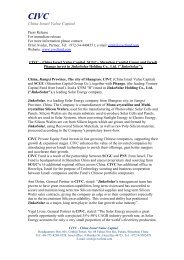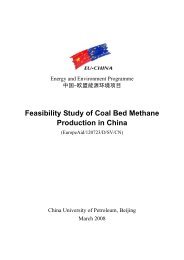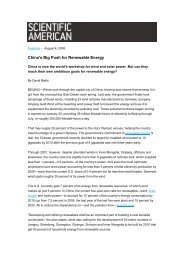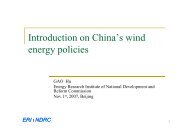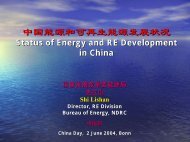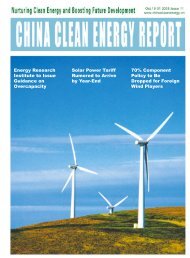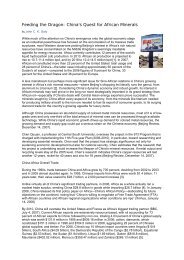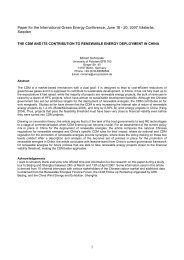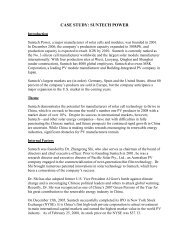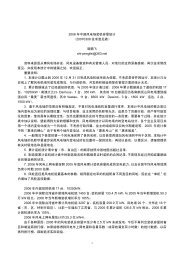LDK Solar Co., Ltd. - Asia Europe Clean Energy (Solar) Advisory Co ...
LDK Solar Co., Ltd. - Asia Europe Clean Energy (Solar) Advisory Co ...
LDK Solar Co., Ltd. - Asia Europe Clean Energy (Solar) Advisory Co ...
You also want an ePaper? Increase the reach of your titles
YUMPU automatically turns print PDFs into web optimized ePapers that Google loves.
‚ the sensitivity of reported results to changes in conditions and assumptions.<br />
We believe the following accounting policies involve the most significant judgments and estimates used in<br />
the preparation of our financial statements:<br />
Depreciation and amortization<br />
Our long-lived assets include property, plant and equipment, and intangible assets relating to technical<br />
know-how. We amortize our long-lived assets using the straight-line method over the estimated useful lives of<br />
the assets, taking into account the assets' estimated residual values. We estimate the useful lives and residual<br />
values at the time we acquire the assets based on our management's knowledge on the useful lives of similar<br />
assets and replacement costs of similar assets having been used for the same useful lives respectively in the<br />
market, and taking into account anticipated technological or other changes. On this basis, we have estimated<br />
the useful lives of our buildings to be 30 years, our plants and machinery to be 10 years, our furniture and<br />
office equipment to be five years and our motor vehicles to be six years. For intangible assets of technical<br />
know-how that we acquire from equipment manufacturers in connection with the operation of our acquired<br />
production equipment, we amortize them over their estimated useful lives of 10 years. We review the<br />
estimated useful life and residual value for each of our long-lived assets on a regular basis. If technological<br />
changes are to occur more rapidly than anticipated, we may shorten the useful lives or lower the residual value<br />
assigned to these assets, which will result in the recognition of increased depreciation and amortization<br />
expense in future periods.<br />
Impairment of long-lived assets<br />
We evaluate our long-lived assets for impairment whenever events or changes in circumstances indicate<br />
that their carrying amounts may not be recoverable, such as change of business plan, obsolescence, and<br />
continuous loss suffered. We assess recoverability of assets by comparing the carrying amount of an asset to<br />
the estimated undiscounted future cash flows expected to be generated by the asset. In determining estimates<br />
of future cash flows, we have to exercise significant judgment in terms of projection of future cash flows and<br />
assumptions. If the carrying amount of an asset exceeds its estimated future cash flows, an impairment charge<br />
is recognized by the amount by which the carrying amount of the asset exceeds its fair value. We estimate the<br />
fair value of an asset based on the best information available, including prices for similar assets and, in the<br />
absence of observable market prices, the result of using a present value technique to estimate the fair value of<br />
the asset. For the periods presented, we recorded no impairment of our long-lived assets.<br />
Share-based compensation<br />
We adopted our 2006 stock incentive plan on July 31, 2006 and have outstanding options granted to<br />
certain of our officers, directors and employees and certain service providers to purchase an aggregate of<br />
8,510,700 ordinary shares as of the date of this prospectus. For a description of our stock options granted,<br />
including the exercise prices and vesting periods, see ""Management Ì 2006 Stock Incentive Plan'' in this<br />
prospectus. Under SFAS 123R, we are required to recognize share-based compensation as compensation<br />
expense in our statement of operations based on the fair value of equity awards on the date of the grant, with<br />
the compensation expense recognized over the period in which the recipient is required to provide service in<br />
exchange for the equity award. A fair value-based method is used for measuring the compensation expense<br />
related to share-based compensation. We estimate our forfeitures based on past employee retention rates and<br />
our expectations of future retention rates, and we will prospectively revise our forfeiture rates based on actual<br />
history. Our stock option compensation charges may change based on changes in our actual forfeitures. We<br />
record compensation expense for the fair value of the options at the grant date. We then amortize share-based<br />
compensation expenses over the vesting periods of the related options.<br />
Determining the fair value of our ordinary shares requires making complex and subjective judgments<br />
regarding projected financial and operating results, our unique business risks, the liquidity of our shares and<br />
our operating history and prospects at the time of grant. Our revenues and earnings growth rates, as well as<br />
major milestones that we have achieved, primarily since the end of 2006, have contributed significantly to the<br />
increase in the fair value of our ordinary shares. However, as we were still a private company prior to the<br />
completion of this offering, the determination of these fair values was inherently uncertain and highly<br />
49



